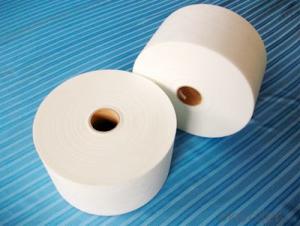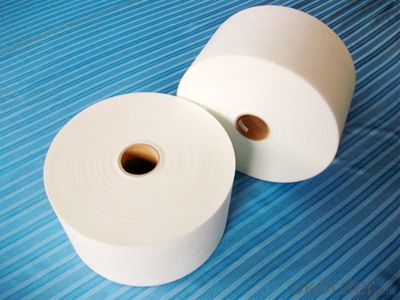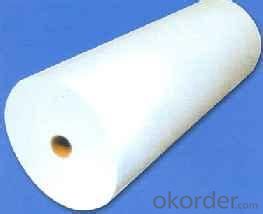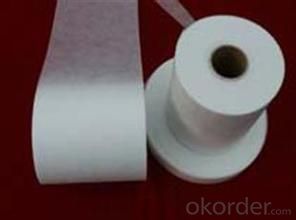Glass Fiber Felt For Pipe Coating
OKorder Service Pledge
OKorder Financial Service
You Might Also Like
Description:
Coated glass fiber mat is dedicated pipeline wet fiberglass mat coated for corrosion protection of buried steel is widely used in petroleum, natural gas pipeline anticorrosion coating.

Main features:
1, fibers uniformly dispersed
2, high strength, good flexibility
3, corrosion resistance, good flame retardant properties
4, anti-permeability good, strong resistance to environmental media capabilities

Technical specifications:
Product Code | Unit Weight(g/㎡) | Gum content(%) | Tendons from(mm) | Longitudinal tensile strength(N/5cm) | The transverse tensile strength(N/5cm) |
S-GD-50/T | 50 | 18 | 15,30 | ≥220 | ≥70 |
S-GD-60/T | 60 | 18 | 15,30 | ≥240 | ≥90 |
S-GD-90/T | 90 | 18 | 15,30 | ≥400 | ≥180 |
Packaging:
with cartons in pallets

FAQ:
1.What is the delivery time ?
15days after receiving the deposit
2.Are you a trading company or factory.
We are factory,and we have more than 10 years of experience.
- Q:How does the surface finish of fiberglass mat tissue affect its adhesion to resin?
- The surface finish of fiberglass mat tissue plays a crucial role in its adhesion to resin. A smooth surface finish allows for better contact and bonding between the tissue and resin, resulting in stronger adhesion. On the other hand, a rough or textured surface finish may hinder the contact area and reduce the bond strength between the tissue and resin. Therefore, a smooth surface finish is generally preferred for achieving optimal adhesion between fiberglass mat tissue and resin.
- Q:Can fiberglass mat tissue be used in corrosive environments?
- The resistance of fiberglass mat tissue to corrosion relies on its specific composition and quality. It can be used to some extent in corrosive environments. Fiberglass mat tissue is manufactured by combining fiberglass strands with a binder material. Although fiberglass itself is generally resistant to corrosion, the binder material used in the mat tissue can vary and impact its resistance to corrosive environments. Certain binders may offer better protection against corrosion, while others may be more prone to degradation. To enhance the corrosion resistance of fiberglass mat tissue in corrosive environments, it is possible to apply additional protective coatings or treatments. These coatings create a barrier against corrosive elements and prolong the material's lifespan. To determine the suitability of fiberglass mat tissue for a specific application, it is crucial to consider the particular corrosive environment and seek advice from experts or manufacturers. They can provide guidance on the ideal composition, treatment, and necessary precautions to ensure optimal performance and durability in corrosive environments.
- Q:How does the roll diameter of fiberglass mat tissue affect its handling?
- The handling of fiberglass mat tissue can be significantly impacted by the diameter of the roll. When the roll diameter is larger, the roll becomes heavier and bulkier, which poses a greater challenge for handling and maneuvering. This is especially important when the fiberglass mat tissue needs to be transported or installed manually. Furthermore, lifting and moving a larger roll diameter requires more physical effort, putting strain on those handling it. Additionally, larger roll diameters occupy more space, making storage and transportation more complicated. On the other hand, a smaller roll diameter makes the fiberglass mat tissue easier to handle due to its lighter and more compact nature. This is particularly advantageous in situations that involve frequent movement and installation, such as construction sites or manufacturing facilities. Moreover, a smaller roll diameter allows for more efficient storage and transportation as it takes up less space and can be easily stacked. This optimization of logistics helps minimize the costs associated with storage and transportation. In summary, the roll diameter of fiberglass mat tissue directly impacts its handling characteristics. Larger diameters make handling more challenging, while smaller diameters provide easier handling and improved storage efficiency.
- Q:Is fiberglass mat tissue resistant to solvents?
- Yes, fiberglass mat tissue is resistant to solvents. Fiberglass mat tissue is made from woven fiberglass fibers that are then coated with a binder. This binder provides a protective layer that makes the tissue resistant to solvents. Solvents are typically used to dissolve, thin, or clean materials, and they can potentially deteriorate or damage certain materials. However, fiberglass mat tissue is specifically designed to withstand the effects of solvents, making it a reliable choice for applications where exposure to solvents is expected.
- Q:What are the different methods of bonding fiberglass mat tissue to other materials?
- There are several methods of bonding fiberglass mat tissue to other materials, each with its own advantages and considerations. Some of the common methods include: 1. Mechanical Bonding: This method involves physically interlocking the fiberglass mat tissue with the other material. It can be achieved through techniques such as stitching, stapling, or using mechanical fasteners like screws or nails. Mechanical bonding provides a strong and durable connection, but it may require additional hardware and can be time-consuming. 2. Adhesive Bonding: Adhesive bonding is a popular method that uses adhesives or glue to join the fiberglass mat tissue with the other material. This method offers flexibility, as there are various types of adhesives available for different applications. It is important to choose an adhesive that is compatible with both the fiberglass mat tissue and the other material. Proper surface preparation and application techniques are crucial for achieving a strong bond. 3. Resin Infusion: Resin infusion is a process where a liquid resin is infused into the fiberglass mat tissue and other materials, creating a strong bond when cured. This method is commonly used in manufacturing composite products, as it allows for a seamless and uniform bond. Vacuum bagging or resin infusion techniques are typically employed to ensure proper resin distribution and consolidation. 4. Thermal Bonding: Thermal bonding involves the use of heat to bond the fiberglass mat tissue to another material. This method is particularly suitable for thermoplastic materials, as they can be softened and fused together with heat. Techniques such as heat welding or ultrasonic welding are commonly used for thermal bonding. It is important to ensure that the heat does not damage or degrade the fiberglass mat tissue during the bonding process. 5. Fusion Bonding: Fusion bonding is a method where the fiberglass mat tissue and the other material are heated to a molten state and then brought into contact to form a bond. This technique is commonly used in the manufacturing of thermosetting plastics or joining thermoplastic materials. Fusion bonding can provide a strong and seamless bond, but it requires careful control of temperature and pressure to ensure proper bonding without causing damage. In summary, the different methods of bonding fiberglass mat tissue to other materials include mechanical bonding, adhesive bonding, resin infusion, thermal bonding, and fusion bonding. The choice of bonding method depends on factors such as the materials being bonded, the desired strength and durability, and the specific application requirements.
- Q:Can fiberglass mat tissue be used for making electrical enclosures?
- No, fiberglass mat tissue cannot be used for making electrical enclosures. Electrical enclosures require materials that have high electrical insulation properties, such as non-conductive plastics or metals, to ensure safety and prevent electrical hazards.
- Q:Is fiberglass mat tissue suitable for insulation in wastewater treatment plants?
- Indeed, fiberglass mat tissue proves to be a suitable option for insulation within wastewater treatment plants. To prevent the dissipation of heat, regulate temperature, and safeguard against corrosion, insulation becomes a frequent necessity in such facilities. Owing to its elevated thermal resistance, exceptional chemical resistance, and durability, fiberglass mat tissue emerges as a commonly employed material for insulation in these establishments. By effectively insulating pipelines, storage tanks, and other equipment within wastewater treatment plants, it guarantees optimal functionality and energy efficiency. Furthermore, its lightweight nature, ease of installation, and cost-effectiveness render fiberglass mat tissue a pragmatic selection for insulation in these rigorous environments.
- Q:What are the different thickness tolerances for fiberglass mat tissue?
- The different thickness tolerances for fiberglass mat tissue can vary depending on the specific manufacturer and product specifications. However, in general, fiberglass mat tissue is available in various thickness tolerances ranging from 0.5 millimeters (mm) to 3 mm. The tolerance refers to the acceptable range of thickness variation within a certain product. For example, a fiberglass mat tissue with a thickness tolerance of +/- 0.5 mm means that the actual thickness of the tissue can vary by up to 0.5 mm in either direction from the specified thickness. The specific tolerance required for a particular application depends on the intended use and the level of precision needed. Thicker fiberglass mat tissues with smaller tolerances are often used in applications that require higher strength and durability, such as in the construction industry for reinforcing concrete or in the manufacturing of composite materials. On the other hand, thinner fiberglass mat tissues with larger tolerances may be used in applications where flexibility and conformability are more important, such as in the automotive industry for insulation or soundproofing purposes. It is important to consult the manufacturer's specifications or contact a supplier for accurate information on the available thickness tolerances for fiberglass mat tissue, as they can vary significantly depending on the specific product and supplier.
- Q:Is fiberglass mat tissue suitable for insulation in data centers?
- Yes, fiberglass mat tissue is a suitable material for insulation in data centers. It provides excellent thermal insulation properties, helping to maintain the desired temperature and prevent heat loss. Additionally, fiberglass is fire-resistant and can offer acoustic insulation, reducing noise levels in the data center. Overall, fiberglass mat tissue is a reliable and effective choice for insulation in data centers.
- Q:How is fiberglass mat tissue used in the production of windshields?
- Fiberglass mat tissue is a crucial component in the production of windshields due to its unique properties and functions. When manufacturing windshields, the fiberglass mat tissue is used as a reinforcement material to enhance the strength and durability of the glass. During the production process, a layer of fiberglass mat tissue is inserted between two layers of glass to create a laminated structure. This layer acts as a barrier, preventing the glass from shattering into small dangerous pieces upon impact. It helps to hold the glass together, providing safety to the vehicle occupants. The fiberglass mat tissue serves as a reinforcing material, improving the mechanical properties of the windshield. It enhances the impact resistance, making the windshield less prone to cracks or chips from stones, debris, or other objects that may hit it while driving. This reinforcement also adds structural integrity to the windshield, allowing it to withstand extreme weather conditions and vibrations without compromising its functionality. Furthermore, the fiberglass mat tissue helps to reduce noise transmission and vibrations. It has sound-damping properties, which contribute to a quieter and more comfortable driving experience by reducing external noise from entering the vehicle cabin. Additionally, the use of fiberglass mat tissue allows for the production of curved windshields. The flexibility of the material enables it to conform to different shapes and contours, allowing manufacturers to create windshields with customized designs and improved aerodynamics. In summary, fiberglass mat tissue plays a vital role in the production of windshields. Its reinforcement properties enhance the strength and impact resistance of the glass, providing safety to the vehicle occupants. It also contributes to a quieter driving experience and enables the production of curved windshields with improved aerodynamics.
1. Manufacturer Overview |
|
|---|---|
| Location | |
| Year Established | |
| Annual Output Value | |
| Main Markets | |
| Company Certifications | |
2. Manufacturer Certificates |
|
|---|---|
| a) Certification Name | |
| Range | |
| Reference | |
| Validity Period | |
3. Manufacturer Capability |
|
|---|---|
| a)Trade Capacity | |
| Nearest Port | |
| Export Percentage | |
| No.of Employees in Trade Department | |
| Language Spoken: | |
| b)Factory Information | |
| Factory Size: | |
| No. of Production Lines | |
| Contract Manufacturing | |
| Product Price Range | |
Send your message to us
Glass Fiber Felt For Pipe Coating
OKorder Service Pledge
OKorder Financial Service
Similar products
New products
Hot products
Hot Searches
Related keywords


































